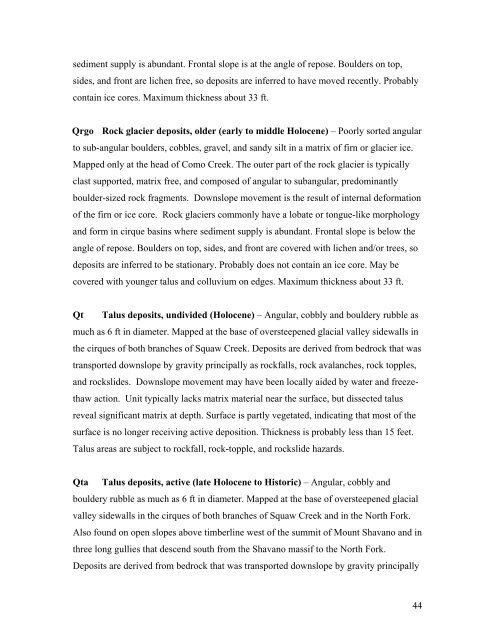Geologic Map of the Maysville Quadrangle, Chaffee County, Colorado
Geologic Map of the Maysville Quadrangle, Chaffee County, Colorado
Geologic Map of the Maysville Quadrangle, Chaffee County, Colorado
Create successful ePaper yourself
Turn your PDF publications into a flip-book with our unique Google optimized e-Paper software.
sediment supply is abundant. Frontal slope is at <strong>the</strong> angle <strong>of</strong> repose. Boulders on top,<br />
sides, and front are lichen free, so deposits are inferred to have moved recently. Probably<br />
contain ice cores. Maximum thickness about 33 ft.<br />
Qrgo Rock glacier deposits, older (early to middle Holocene) – Poorly sorted angular<br />
to sub-angular boulders, cobbles, gravel, and sandy silt in a matrix <strong>of</strong> firn or glacier ice.<br />
<strong>Map</strong>ped only at <strong>the</strong> head <strong>of</strong> Como Creek. The outer part <strong>of</strong> <strong>the</strong> rock glacier is typically<br />
clast supported, matrix free, and composed <strong>of</strong> angular to subangular, predominantly<br />
boulder-sized rock fragments. Downslope movement is <strong>the</strong> result <strong>of</strong> internal deformation<br />
<strong>of</strong> <strong>the</strong> firn or ice core. Rock glaciers commonly have a lobate or tongue-like morphology<br />
and form in cirque basins where sediment supply is abundant. Frontal slope is below <strong>the</strong><br />
angle <strong>of</strong> repose. Boulders on top, sides, and front are covered with lichen and/or trees, so<br />
deposits are inferred to be stationary. Probably does not contain an ice core. May be<br />
covered with younger talus and colluvium on edges. Maximum thickness about 33 ft.<br />
Qt Talus deposits, undivided (Holocene) – Angular, cobbly and bouldery rubble as<br />
much as 6 ft in diameter. <strong>Map</strong>ped at <strong>the</strong> base <strong>of</strong> oversteepened glacial valley sidewalls in<br />
<strong>the</strong> cirques <strong>of</strong> both branches <strong>of</strong> Squaw Creek. Deposits are derived from bedrock that was<br />
transported downslope by gravity principally as rockfalls, rock avalanches, rock topples,<br />
and rockslides. Downslope movement may have been locally aided by water and freezethaw<br />
action. Unit typically lacks matrix material near <strong>the</strong> surface, but dissected talus<br />
reveal significant matrix at depth. Surface is partly vegetated, indicating that most <strong>of</strong> <strong>the</strong><br />
surface is no longer receiving active deposition. Thickness is probably less than 15 feet.<br />
Talus areas are subject to rockfall, rock-topple, and rockslide hazards.<br />
Qta Talus deposits, active (late Holocene to Historic) – Angular, cobbly and<br />
bouldery rubble as much as 6 ft in diameter. <strong>Map</strong>ped at <strong>the</strong> base <strong>of</strong> oversteepened glacial<br />
valley sidewalls in <strong>the</strong> cirques <strong>of</strong> both branches <strong>of</strong> Squaw Creek and in <strong>the</strong> North Fork.<br />
Also found on open slopes above timberline west <strong>of</strong> <strong>the</strong> summit <strong>of</strong> Mount Shavano and in<br />
three long gullies that descend south from <strong>the</strong> Shavano massif to <strong>the</strong> North Fork.<br />
Deposits are derived from bedrock that was transported downslope by gravity principally<br />
44




